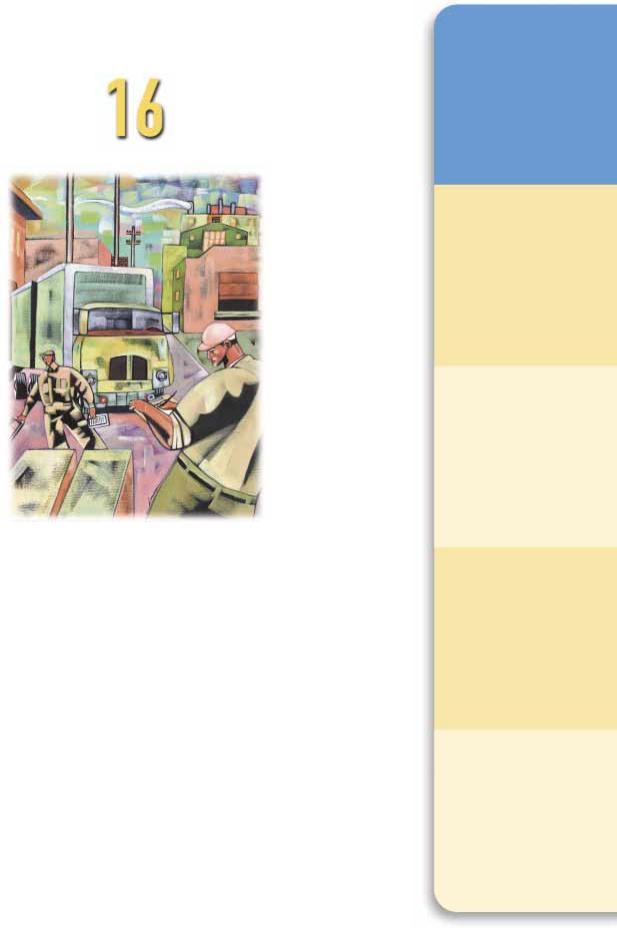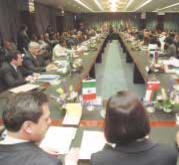
Mankiw Principles of Economics (3rd ed)
.pdf




356 |
PART FIVE FIRM BEHAVIOR AND THE ORGANIZATION OF INDUSTRY |
John and Joan suddenly discover water sources on their property and join Jack and Jill in the water oligopoly. The demand schedule in Table 16-1 remains the same, but now more producers are available to satisfy this demand. How would an increase in the number of sellers from two to four affect the price and quantity of water in the town?
If the sellers of water could form a cartel, they would once again try to maximize total profit by producing the monopoly quantity and charging the monopoly price. Just as when there were only two sellers, the members of the cartel would need to agree on production levels for each member and find some way to enforce the agreement. As the cartel grows larger, however, this outcome is less likely. Reaching and enforcing an agreement becomes more difficult as the size of the group increases.
If the oligopolists do not form a cartel—perhaps because the antitrust laws prohibit it—they must each decide on their own how much water to produce. To see how the increase in the number of sellers affects the outcome, consider the decision facing each seller. At any time, each well owner has the option to raise production by 1 gallon. In making this decision, the well owner weighs two effects:
The output effect: Because price is above marginal cost, selling 1 more gallon of water at the going price will raise profit.
The price effect: Raising production will increase the total amount sold, which will lower the price of water and lower the profit on all the other gallons sold.
If the output effect is larger than the price effect, the well owner will increase production. If the price effect is larger than the output effect, the owner will not raise production. (In fact, in this case, it is profitable to reduce production.) Each oligopolist continues to increase production until these two marginal effects exactly balance, taking the other firms’ production as given.
Now consider how the number of firms in the industry affects the marginal analysis of each oligopolist. The larger the number of sellers, the less concerned each seller is about its own impact on the market price. That is, as the oligopoly grows in size, the magnitude of the price effect falls. When the oligopoly grows very large, the price effect disappears altogether, leaving only the output effect. In this extreme case, each firm in the oligopoly increases production as long as price is above marginal cost.
We can now see that a large oligopoly is essentially a group of competitive firms. A competitive firm considers only the output effect when deciding how much to produce: Because a competitive firm is a price taker, the price effect is absent. Thus, as the number of sellers in an oligopoly grows larger, an oligopolistic market looks more and more like a competitive market. The price approaches marginal cost, and the quantity produced approaches the socially efficient level.
This analysis of oligopoly offers a new perspective on the effects of international trade. Imagine that Toyota and Honda are the only automakers in Japan, Volkswagen and Mercedes-Benz are the only automakers in Germany, and Ford and General Motors are the only automakers in the United States. If these nations prohibited trade in autos, each would have an auto oligopoly with only two members, and the market outcome would likely depart substantially from the competitive ideal. With international trade, however, the car market is a world market, and the oligopoly in this example has six members. Allowing free trade increases

CHAPTER 16 OLIGOPOLY |
357 |
the number of producers from which each consumer can choose, and this increased competition keeps prices closer to marginal cost. Thus, the theory of oligopoly provides another reason, in addition to the theory of comparative advantage discussed in Chapter 3, why all countries can benefit from free trade.
CASE STUDY OPEC AND THE WORLD OIL MARKET |
|
|
Our story about the town’s market for water is fictional, but if we change water |
|
|
to crude oil, and Jack and Jill to Iran and Iraq, the story is quite close to being |
|
|
true. Much of the world’s oil is produced by a few countries, mostly in the Mid- |
|
|
dle East. These countries together make up an oligopoly. Their decisions about |
|
|
how much oil to pump are much the same as Jack and Jill’s decisions about how |
|
|
much water to pump. |
|
|
|
The countries that produce most of the world’s oil have formed a cartel, |
|
called the Organization of Petroleum Exporting Countries (OPEC). As origi- |
|
|
nally formed in 1960, OPEC included Iran, Iraq, Kuwait, Saudi Arabia, and |
|
|
Venezuela. By 1973, eight other nations had joined: Qatar, Indonesia, Libya, |
OPEC: A NOT VERY COOPERATIVE CARTEL |
|
the United Arab Emirates, Algeria, Nigeria, Ecuador, and Gabon. These coun- |
|
|
tries control about three-fourths of the world’s oil reserves. Like any cartel, |
|
|
OPEC tries to raise the price of its product through a coordinated reduction in |
|
|
quantity produced. OPEC tries to set production levels for each of the member |
|
|
countries. |
|
|
|
The problem that OPEC faces is much the same as the problem that Jack |
|
and Jill face in our story. The OPEC countries would like to maintain a high |
|
|
price of oil. But each member of the cartel is tempted to increase production in |
|
|
order to get a larger share of the total profit. OPEC members frequently agree to |
|
|
reduce production but then cheat on their agreements. |
|
|
|
OPEC was most successful at maintaining cooperation and high prices in |
|
the period from 1973 to 1985. The price of crude oil rose from $2.64 a barrel in |
|
|
1972 to $11.17 in 1974 and then to $35.10 in 1981. But in the early 1980s member |
|
|
countries began arguing about production levels, and OPEC became ineffective |
|
|
at maintaining cooperation. By 1986 the price of crude oil had fallen back to |
|
|
$12.52 a barrel. |
|
|
|
During the 1990s, the members of OPEC met about twice a year, but the car- |
|
tel failed to reach and enforce agreement. The members of OPEC made produc- |
|
|
tion decisions largely independently of one another, and the world market for |
|
|
oil was fairly competitive. Throughout most of the decade, the price of crude |
|
|
oil, adjusted for overall inflation, remained less than half the level OPEC had |
|
|
achieved in 1981. In 1999, however, cooperation among oil-exporting nations |
|
|
started to pick up (see the accompanying In the News box). Only time will tell |
|
|
how persistent this renewed cooperation proves to be. |
|
|
|
||
|
QUICK QUIZ: If the members of an oligopoly could agree on a total |
|
|
|
|
|
quantity to produce, what quantity would they choose? If the oligopolists |
|
|
do not act together but instead make production decisions individually, do |
|
|
they produce a total quantity more or less than in your answer to the previous |
|
|
question? Why? |
|
